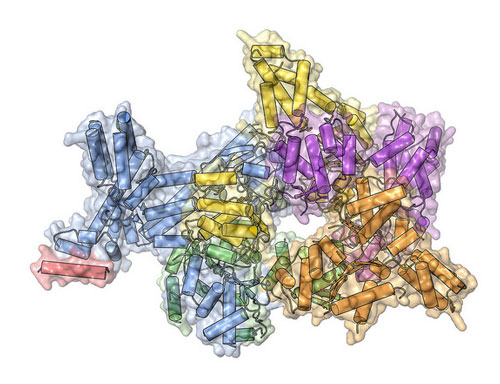| Mar 18, 2015 |
Improved understanding of protein complex offers insight into DNA replication initiation mechanism basics
|
|
(Nanowerk News) A clearer understanding of the origin recognition complex (ORC) – a protein complex that directs DNA replication – through its crystal structure offers new insight into fundamental mechanisms of DNA replication initiation. This will also provide insight into how ORC may be compromised in a subset of patients with Meier-Gorlin syndrome, a form of dwarfism in humans.
|
|
ORC is a six-subunit protein complex that directly binds DNA to recruit other protein factors involved in DNA replication. Researchers collected data at the Advanced Photon Source (APS), a U.S. Department of Energy User Facility based at Argonne National Laboratory, to obtain the first atomic-level resolution picture of this complex.
|
|
The structure shows that ORC's main body has five subunits that contain a common fold that is found in proteins binding ATP, a small molecule that cells use as fuel. One of the largest subunits, ORC3, has a structural element that protrudes from the ORC core to contact ORC6, according to the paper, "Crystal structure of the eukaryotic origin recognition complex", published last week in Nature.
|
 |
| Structural elements of ORC, differentially colored by subunits and with the molecular surface highlighted. The ORC 6 subunit is shown in red. (Image: Franziska Bleichert)
|
|
"The crystal structure explains why a mutation in ORC6 that is linked to Meier-Gorlin syndrome in a subset of patients results in defective binding of this subunit to ORC3," said Franziska Bleichert, the paper's lead author. "The structure also makes specific predictions on how the different ORC protein subunits might interact with DNA in the central channel of ORC and with other replication initiation factors."
|
|
The research team was surprised to learn that a region of subunit ORC1, which is biochemically known to interact with a similar region of ORC4, did not do so in its structure. In fact, this region in ORC1 blocks entry into the central channel and prevents DNA binding. This phenomenon suggests that ORC in multi-cellular organisms can adopt a previously unanticipated inactivated state that is likely important to regulating its activity and preventing inappropriate DNA replication.
|
|
Researchers' access to the APS was important. "The powerful X-ray beam at the APS and the flexible data collection technologies at the (General Medical Sciences and National Cancer Institute (GM/CA) beamlines) – in particular microfocus capabilities and crystal rastering – were critical in obtaining high-quality datasets that allowed us to determine the structure," Bleichert said.
|
|
The research illustrates the importance of understanding the role proteins have in DNA replication, an essential cellular process that needs to be tightly regulated. When deviations in DNA replication occur, cells can end up with fragmented DNA that can lead to cell death and diseases such as cancer.
|

